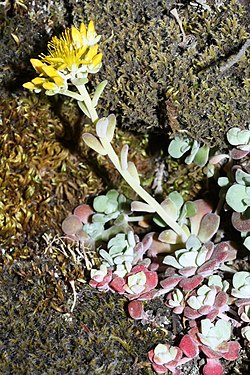Sedum spathulifolium
| Sedum spathulifolium subsp. var. | ||||||||||||||||||||||||||||||||||||||||||||||||||||||||
|---|---|---|---|---|---|---|---|---|---|---|---|---|---|---|---|---|---|---|---|---|---|---|---|---|---|---|---|---|---|---|---|---|---|---|---|---|---|---|---|---|---|---|---|---|---|---|---|---|---|---|---|---|---|---|---|---|

|
|
| ||||||||||||||||||||||||||||||||||||||||||||||||||||||
| ||||||||||||||||||||||||||||||||||||||||||||||||||||||||
Describe plant here...
| Standard Cyclopedia of Horticulture |
|---|
|
Sedum spathulifolium, Hook. Perennial with slender rootstocks, glaucous, ultimately reddish: barren shoots creeping or ascending, 3-4 in. long; fl.-sts. ascending, sometimes 4-8 in. high, simple or sometimes branched: lvs. of barren shoot forming a terminal rosette 1-1 1/2 in. diam. and producing offsets from the base; lower lvs. obovate-spatulate, 1/2 x 3/8 in.; cauline smaller and clavate: fls. numerous, yellow, 1/2 in. across, in terminal forking cymes, with 3-5 principal branches about 3 in. long, these are 2-divided and bear fls. only on the upper side; sepals lanceolate or oblong-lanceolate; petals lanceolate, keeled; anthers yellow. N. W. N. Amer. —Questionable whether it is hardy in the E. CH
|
Cultivation
Propagation
Pests and diseases
Varieties
Gallery
-
photo 1
-
photo 2
-
photo 3
References
- Standard Cyclopedia of Horticulture, by L. H. Bailey, MacMillan Co., 1963
External links
- w:Sedum spathulifolium. Some of the material on this page may be from Wikipedia, under the Creative Commons license.
- Sedum spathulifolium QR Code (Size 50, 100, 200, 500)


